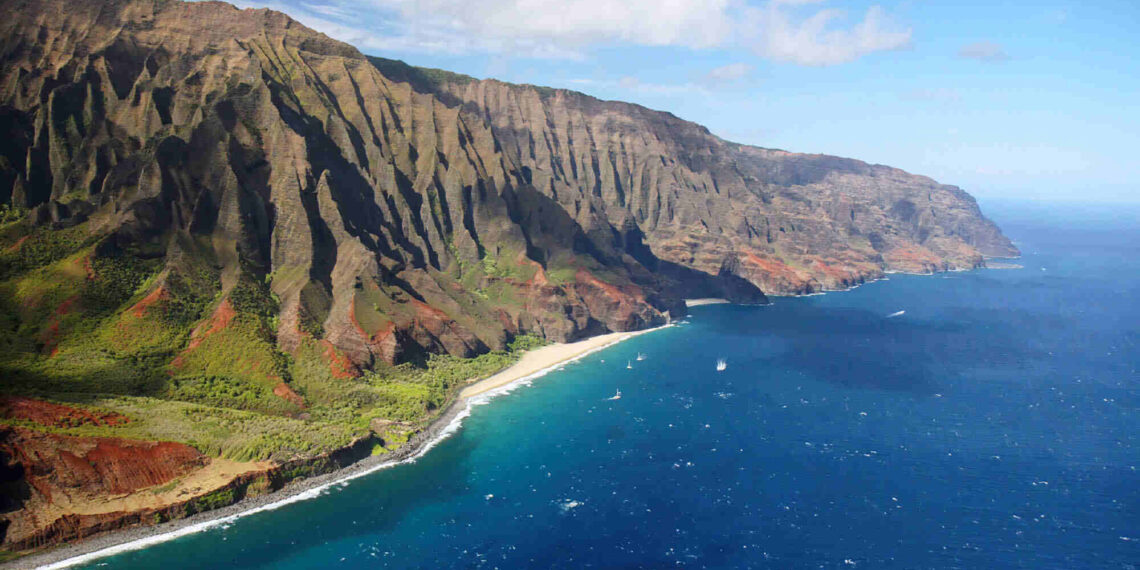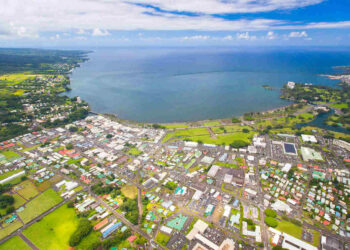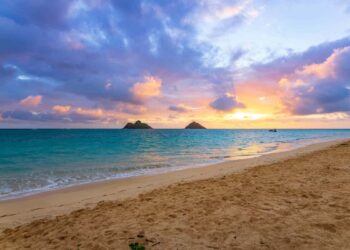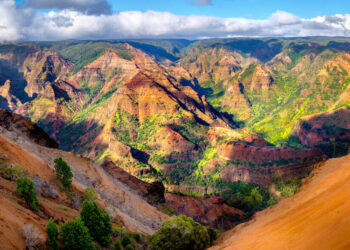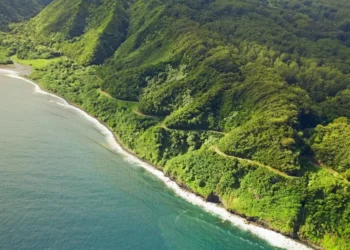The Na Pali Coast stretches along Kauai’s northwestern edge, a rugged line where cliffs rise sharp from the Pacific, their green folds cut by time and tide. This isn’t a gentle shore—it’s a wild stretch, where the land drops steep into deep water, and the wind carries the weight of untouched places. Once home to Hawaiian villages nestled in its valleys, the Na Pali Coast now stands as a testament to nature’s hold, a place where human traces fade against the rock and sea. For those who seek a corner of the world still raw and real, this coast delivers.
Notable Insight: A Hidden Past
“Na Pali” means “the cliffs” in Hawaiian, a fitting name for walls that climb 4,000 feet from the waves. Centuries back, native Hawaiians carved lives here, farming taro in the narrow valleys and fishing the rich waters. Their stone terraces and heiau—sacred sites—still dot the land, though most visitors never see them, lost to the overgrowth or reachable only by the hardiest trekkers.
Places to Visit: An Overview
The Na Pali Coast spans 17 miles of Kauai’s shore, a state wilderness park with no roads in or out—just trails, boats, and the sea. The Kalalau Trail is the backbone, an 11-mile one-way path from Ke’e Beach to Kalalau Valley, winding past cliffs and streams to a beach where the surf pounds hard. Hanakapi’ai Valley, two miles in, offers a taste—its waterfall crashes 300 feet down a sheer face, a reward for the muddy slog. Further along, the Na Pali Coast’s sea caves carve into the rock, dark hollows where waves echo, best seen from a kayak or tour boat.
Nualolo Kai, a reef-fringed cove, holds remnants of an old fishing village—stone walls and platforms—accessible only by permitted vessels. Above, the Awa’awapuhi Trail drops from the inland cliffs at 4,120 feet to a lookout over the coast, a 6.2-mile round trip through forest and ridge. Each spot shows a piece of Na Pali—its height, its depth, its stubborn grip on the past.
How to Reach
Kauai’s Lihue Airport, 30 miles southeast, is the entry point, with flights from Honolulu (40 minutes) or mainland hubs like Seattle (6 hours). From there, rent a car—public transit doesn’t touch Na Pali. Drive Highway 56 west to its end at Ke’e Beach, 40 miles and an hour’s trip, where the Kalalau Trail starts. Parking’s tight; get there by 7 a.m. or shuttle from Hanalei ($15, book ahead). For the coast’s full sweep, boat tours launch from Port Allen, 20 miles south of Lihue—$150-$200 for a half-day, zodiacs or catamarans cutting through swells.
Kayaking’s another way—rentals from Hanalei Bay run $60 a day, a 17-mile paddle along the shore, permitted May to September only. No ferries or direct flights drop you closer; it’s a trek or a float to reach this edge. Trail permits ($35/day) are required past Hanakapi’ai, nabbed through Hawaii’s state portal—slots vanish months out.
Experiencing Na Pali Coast
The Kalalau Trail
The trail’s no stroll—22 miles round-trip, steep drops, and slick mud after rain. Hanakapi’ai’s a 4-mile taste, two hours each way, crossing a stream that swells fast in storms. The full haul to Kalalau Beach takes 8-12 hours one way, past Crawler’s Ledge—a narrow shelf with a 500-foot fall. The beach at the end’s wide, with a waterfall and caves, but the surf’s rough—swim with care. Campers stay here, tents pitched under cliffs.
By Sea
Boats show what feet can’t reach—caves like the Open Ceiling, a lava tube with a skylight, or Waiahuakua, 1,100 feet long, where water drips cold. Tours stop at Nualolo Kai if conditions hold, letting you walk the old village ground. Kayaks hug the shore closer, slipping into nooks boats miss—bring a dry bag; you’ll get soaked. Dolphins spin by sometimes, and turtles bob near the reefs.
From Above
Awa’awapuhi Trail’s a drier way—3-4 hours round-trip, descending 1,600 feet to a perch over the coast. The view’s wide—Nualolo Valley to the sea—without the trail’s grind. Helicopters buzz overhead too, $300 for an hour from Lihue, circling cliffs and falls.
Frequently Asked Questions About Na Pali Coast
Is the trail safe for beginners?
Not really. Past Hanakapi’ai, it’s steep and exposed—fit hikers only. The first two miles are moderate but slippery; wear boots, not sandals.
When’s the best time to visit?
Summer—May to September—dries the trail and calms the sea. Winter brings rain and 20-foot waves; boats cancel, trails flood.
Can you swim everywhere?
No. Kalalau Beach has riptides, and caves flood quick. Hanakapi’ai’s stream is deadly in high water—check forecasts.
Are there facilities?
None. No bathrooms, no water stations—pack 3-4 liters per day. Campers dig catholes; leave no trace.
Where to Stay
Kalalau Campground
At trail’s end, free with a permit—tents only, no cabins. Waves crash close; pack earplugs and a tarp for rain.
Hanalei Colony Resort
10 miles east in Hanalei, cottages with kitchens, $250-$350 a night. Near the trailhead, quiet after dark.
Westin Princeville
15 miles from Ke’e, upscale rooms with cliff views, $300-$450. A base if you’re not camping.
Dining Nearby
Tahiti Nui
In Hanalei, 10 miles off, $15 pizzas and $10 mai tais, a local dive with live tunes some nights.
Postcards Café
Also Hanalei, $20 fish plates, cozy with porch seating. Fresh catch, no rush.
Kountry Kitchen
Kapaa, 25 miles south, $12 pancakes or loco moco. Hearty stop pre- or post-trek.
Final Thoughts
The Na Pali Coast isn’t easy—it’s a place that asks something of you. The trail tests your legs, the sea your nerve, the cliffs your sense of scale. It’s where Hawaiians once thrived, their marks faint now under the green, and where the land still rules. You’ll hear the waves’ steady beat, feel the wind off the heights, see a valley open like a secret kept. It’s not a quick pass-through; it’s a stretch of earth that sticks with you, real and rough. Whether you hike, paddle, or just look out, Na Pali’s got a piece of Kauai’s core, waiting for you to take it on.
